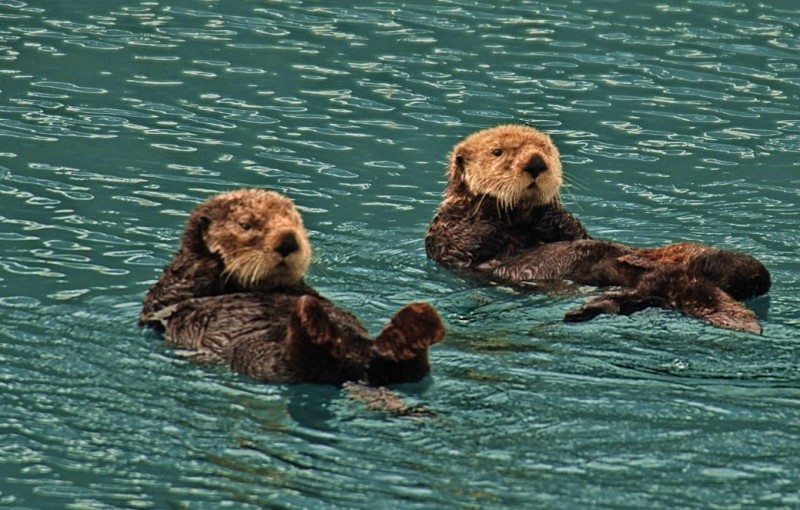
When it comes to endearing marine creatures, sea otters are undoubtedly at the top of the list. These captivating mammals, found along the coasts of the northern Pacific Ocean, have garnered much attention for their adorable antics and social behaviors. One peculiar and heartwarming behavior that has captured the imagination of people worldwide is their tendency to hold hands while sleeping. In this article, we will explore the fascinating world of sea otters and delve into the reasons behind this charming behavior.
The Fascinating World of Sea Otters
Characteristics and Habitat
Sea otters are the smallest marine mammals and are well-adapted to a life in the water. Their dense fur, comprising two layers, provides excellent insulation and buoyancy, enabling them to stay warm in cold waters. Unlike other marine mammals, sea otters lack a blubber layer, making their fur vital for survival.
These captivating creatures inhabit nearshore environments, including rocky shores, kelp forests, and estuaries. They are known for their dexterity and intelligence, often using tools like rocks to crack open shellfish for food.
Social Behavior
Sea otters are highly social animals, and they exhibit a range of behaviors that emphasize their strong sense of community. They can be observed playing, grooming, and foraging together, creating bonds that are essential for their well-being.
The Surprising Behavior of Holding Hands
Keeping From Drifting Apart
One of the most endearing and widely known behaviors of sea otters is their tendency to hold hands while resting or sleeping in groups. This charming practice is not merely a display of affection; it serves a practical purpose. Sea otters face a unique challenge when resting in the water - the risk of drifting apart due to currents. By holding hands, they create "rafts" of otters, ensuring they stay together and are not separated.
Forming Rafts
The hand-holding behavior is not limited to small groups; it can extend to larger gatherings known as rafts. Rafts can consist of hundreds of sea otters, each holding hands with its neighbors. These rafts serve as a form of protection, especially for younger otters, as they provide safety in numbers and help deter potential predators.
The Bond Between Mother and Pup
The bond between a mother sea otter and her pup is incredibly strong. Sea otter mothers are known for their nurturing and attentive nature. To ensure the pup's safety, the mother wraps her pup in strands of kelp while she goes off to forage for food. This natural "crib" keeps the pup secured and prevents it from drifting away.
The Role of Communication
Sea otters use various vocalizations and body language to communicate with each other. The holding hands behavior is one of the ways they express their social connection and maintain contact within the group. By doing so, they strengthen their bond and foster a sense of camaraderie among the otters.
Sea Otters' Role in Ecosystems
Sea otters play a vital role in maintaining the health of coastal ecosystems. As voracious eaters of sea urchins, crabs, and other invertebrates, they help control the populations of these species, preventing overgrazing of kelp forests. Thriving kelp forests, in turn, provide essential habitat and protection for numerous marine species.
Conservation Efforts
Despite their significant ecological importance, sea otters have faced various threats over the years, including hunting, pollution, and habitat loss. Conservation efforts have been underway to protect and restore sea otter populations. These efforts have led to positive outcomes in some regions, but more work is needed to ensure their long-term survival.
Threats to Sea Otters
Several factors continue to pose threats to sea otters, such as entanglement in fishing gear, oil spills, and disease outbreaks. Climate change also impacts their habitats, leading to changes in food availability and ocean conditions, further challenging their survival.
The Importance of Protecting Sea Otters
Protecting sea otters is crucial for maintaining the delicate balance of marine ecosystems. As a keystone species, their presence or absence can have far-reaching effects on the coastal environment. By safeguarding sea otters, we are not only preserving an adorable marine species but also ensuring the well-being of the entire ecosystem.
In conclusion, sea otters' charming behavior of holding hands while sleeping goes beyond mere cuteness; it reflects their strong social bonds and serves as a survival strategy to stay together in the water. As we continue to learn more about these captivating creatures, it becomes evident that they are essential components of healthy marine ecosystems. However, to secure their future, we must actively engage in conservation efforts and work collectively to protect these adorable ambassadors of the sea.
Home-Seekers Flock to Gruha Lakshmi Registration in Bengaluru
Outrage in Maharashtra: Leader Fadnavis Vows Action Against Those Defaming Savitribai Phule!
BREAKING: Gyanvapi ASI Survey, Allahabad HC Reserves Order For Aug 3